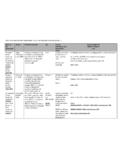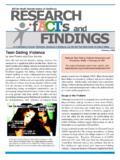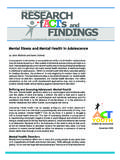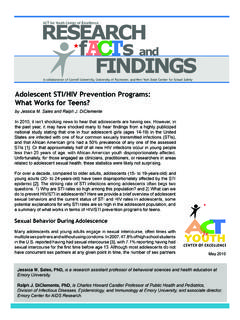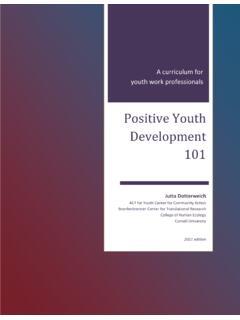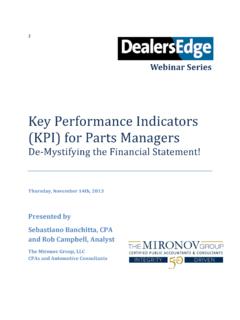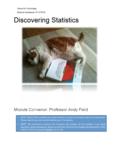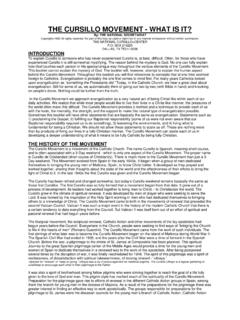Transcription of ACT for Youth Upstate Center of Excellence …
1 ACT for Youth Upstate Center of Excellence RESEARCH. F S and FINDINGS. A collaboration of Cornell University, University of Rochester, and the NYS Center for School Safety May 2002. Adolescent Brain Development Research now supports what parents have long suspected that the teenager's brain is different than the adult brain. Recent research by scientists at the National Institute of Mental Health (NIMH) using magnetic resonance imaging (MRI) has found that the teen brain is not a finished product, but is a work in progress. Until recently most scientists believed that the major "wiring" of the brain was completed by as early as three years of age and that the brain was fully mature by the age of 10 or 12.
2 New findings show that the greatest changes to the parts of the brain that are responsible for functions such as self-control, judgment, emotions, and organization occur between puberty and adult- hood. This may help to explain certain teenage behavior that adults can find mystifying, such as poor decision-making, recklessness, and emotional outbursts. The brain is still developing during the teen years Dr. Jay Giedd of the NIMH has reported that brain maturation does not stop at age 10, but continues into the teen years and even into the 20's. What is most surprising is that you get a second wave of overproduc- tion of gray matter, something that was thought to happen only in the first 18 months of life (Begley, 2000).
3 Following the overproduction of gray matter, the brain undergoes a process called pruning where connections among neurons in the brain that are not used wither away, while those that are used stay the use it or lose it principle. It is thought that this pruning process makes the brain more efficient by strengthening the connections that are used most often, and eliminating the clutter of those that are not used at all. What does this mean for teens? According to Dr. Giedd, this is exciting news for teens. unlike infants whose brain activity is completely determined by their parents and en- vironment, the teens may actually be able to control how their own brains are wired and sculpted.
4 Kids who exercise their brains by learning to order their thoughts, under- stand abstract concepts, and control their impulses are laying the neural foundations that will serve them for the rest of their lives. "This argues for doing a lot of things as a teenager," says Dr. Giedd. "You are hard-wiring your brain in adolescence. Do you want to hard-wire it for sports and playing music and doing mathematics or for lying on the couch in front of the television?". 2. Alcohol use and the developing teen brain Recent research suggests that alcohol use affects adolescents and adults differently, which makes sense given what we now know about the changes going on in the teen brain.
5 While more research needs to be done in this area, Duke University scientists say the available research suggests that adolescents are more vulnerable than adults to the affects of alcohol on learning and memory (White, 2001). Not only do they react differently to the initial affects of alcohol, studies suggest that teens who repeatedly use alcohol can suffer long-term effects. Preliminary studies using rats have shown that those with repeated alcohol exposure during adolescence are more sensitive to alcohol- induced impairments later in life (White, 2001). Research on humans by Brown, et al.
6 (2000) has shown the first concrete evidence that heavy, on-going alcohol use by adolescents can impair brain functioning. Brown's re- search on 15 and 16 year olds showed cognitive impairments in teen alcohol abusers, compared with non-abusing peers, even weeks after they stop drinking. This suggests that abuse of alcohol by teens may have long-term negative effects on the make up of their brains. Teens and understanding emotions Teens also differ from adults in their ability to read and understand emotions in the faces of others. Recent research shows that teens and adults actually use different regions of the brain in responding to certain tasks.
7 In a study conducted at Boston's McLean Hospital, psychologist Deborah Yurgelun-Todd and col- leagues showed pictures of people wearing fearful expressions to teenagers between the ages of 11 and 17 while the teens had their brains scanned using functional magnetic resonance imaging (fMRI). She found that compared to adults the teens' frontal lobes (the seat of goal-oriented rational thinking) are less active and their amygdala (a structure in the temporal lobe that is involved in discriminating fear and other emotions) is more ac- tive. The teens often misread facial expressions, with those under the age of 14 more of- ten seeing sadness or anger or confusion instead of fear.
8 Older teenagers answered cor- rectly more often and exhibited a progressive shift of activity from the amygdala to the frontal lobes. The results suggest that "in teens, the judgment, insight and reasoning Brain Regions and functions Frontal lobe self-control, judgment, emotional regulation; restructured in teen years Corpus callosum intelligence, consciousness and self-awareness; reaches full maturity in 20's Parietal lobes integrate auditory, visual, and tactile signals; immature until age 16. Temporal lobes emotional maturity; still developing after age 16. 3. power of the frontal cortex is not being brought to bear on the task as it is in adults.
9 Teens just process information differently from adults. (Yurgelun-Todd, 2002)". Implications It is important to note that experts caution careful interpretation of this new information about adolescent brain development, as it is still very early in the analysis and understanding of what it all means. Yet it is also true that these findings add new dimensions to issues facing young people, as well as their parents and teachers, and they pose a challenge to policy makers (NIH, 2000). If the choices adolescents make about using drugs and alcohol and engaging in or avoiding challenging learning tasks have long-term and irreversible consequences for the development of their brains, then discouraging harmful choices and encouraging healthy ones is all the more urgent.
10 This new research may also provide a compelling explanation for why adolescents often fail to heed adults' warnings about such choices; they may simply not be able to understand and accept arguments that seem logical and decisive to adults. It is also possible that teens are misperceiving or misunderstanding the emotions of adults, leading to miscom- munication both in terms of what the teen thinks the adult is feeling and in terms of the teen's response. Perhaps most importantly, teenagers are empowered with opportunities to develop their brains through the activities in which they choose to participate.
